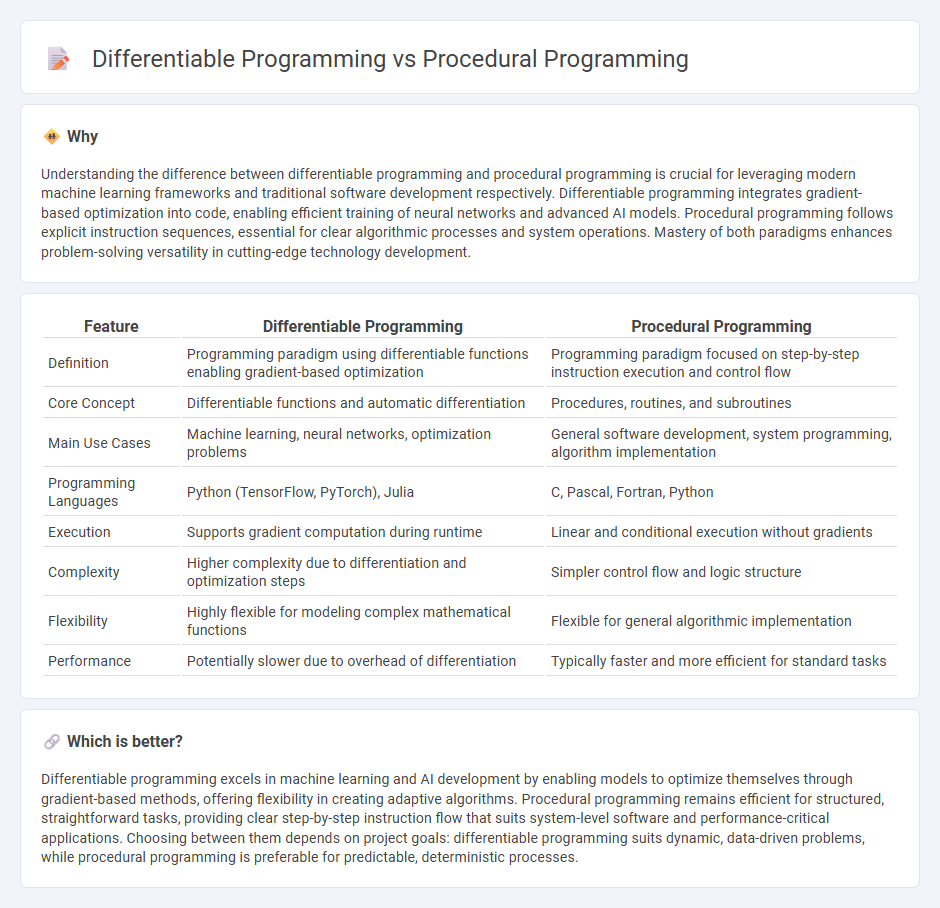
Differentiable programming integrates gradient-based optimization directly into code, enabling machine learning models to learn complex patterns efficiently, whereas procedural programming follows explicit step-by-step instructions to perform tasks. This paradigm shift enhances adaptability in artificial intelligence by allowing programs to adjust through training rather than static commands. Explore how differentiable programming transforms algorithm design and accelerates technological innovation.
Why it is important
Understanding the difference between differentiable programming and procedural programming is crucial for leveraging modern machine learning frameworks and traditional software development respectively. Differentiable programming integrates gradient-based optimization into code, enabling efficient training of neural networks and advanced AI models. Procedural programming follows explicit instruction sequences, essential for clear algorithmic processes and system operations. Mastery of both paradigms enhances problem-solving versatility in cutting-edge technology development.
Comparison Table
| Feature | Differentiable Programming | Procedural Programming |
|---|---|---|
| Definition | Programming paradigm using differentiable functions enabling gradient-based optimization | Programming paradigm focused on step-by-step instruction execution and control flow |
| Core Concept | Differentiable functions and automatic differentiation | Procedures, routines, and subroutines |
| Main Use Cases | Machine learning, neural networks, optimization problems | General software development, system programming, algorithm implementation |
| Programming Languages | Python (TensorFlow, PyTorch), Julia | C, Pascal, Fortran, Python |
| Execution | Supports gradient computation during runtime | Linear and conditional execution without gradients |
| Complexity | Higher complexity due to differentiation and optimization steps | Simpler control flow and logic structure |
| Flexibility | Highly flexible for modeling complex mathematical functions | Flexible for general algorithmic implementation |
| Performance | Potentially slower due to overhead of differentiation | Typically faster and more efficient for standard tasks |
Which is better?
Differentiable programming excels in machine learning and AI development by enabling models to optimize themselves through gradient-based methods, offering flexibility in creating adaptive algorithms. Procedural programming remains efficient for structured, straightforward tasks, providing clear step-by-step instruction flow that suits system-level software and performance-critical applications. Choosing between them depends on project goals: differentiable programming suits dynamic, data-driven problems, while procedural programming is preferable for predictable, deterministic processes.
Connection
Differentiable programming integrates mathematical optimization into procedural programming by enabling algorithms to compute gradients through procedures, enhancing machine learning model training. Procedural programming structures code with explicit control flows, which differentiable programming extends using automatic differentiation to optimize complex functions. This connection facilitates efficient implementation of neural networks and scientific computations within procedural frameworks.
Key Terms
Control Flow
Procedural programming relies on explicit control flow structures such as loops, conditionals, and sequential statements to dictate the step-by-step execution of a program. Differentiable programming leverages continuous, differentiable control flow mechanisms that enable gradient-based optimization through techniques like automatic differentiation in neural networks. Explore the nuances of control flow in these paradigms to optimize your program design effectively.
Gradient Descent
Procedural programming follows explicit step-by-step instructions, executing code sequentially without inherent support for differentiating functions, whereas differentiable programming integrates automatic differentiation enabling gradient-based optimization methods like Gradient Descent to efficiently update model parameters. Gradient Descent leverages gradients calculated via differentiable programming to minimize loss functions in machine learning, enhancing performance over traditional procedural approaches that lack native differentiation capabilities. Explore how Gradient Descent transforms optimization in differentiable programming for deeper insights.
Automatic Differentiation
Procedural programming follows a step-by-step set of instructions for computations, whereas differentiable programming integrates automatic differentiation to compute gradients efficiently within complex models. Automatic differentiation, essential in differentiable programming, enables precise gradient evaluations by decomposing functions into elementary operations and systematically applying the chain rule. Explore more to understand how automatic differentiation revolutionizes optimization and machine learning workflows.
Source and External Links
Procedural programming - Wikipedia - Procedural programming is an imperative programming paradigm where programs are structured as procedures (functions, subroutines) that call each other in a sequence to perform tasks, emphasizing modularity and scope to improve code quality and reusability.
Procedural Programming - DeepSource - Procedural programming organizes programs as sequences of instructions grouped into procedures, which can have local scope and access global variables, supporting structured programming and logical flow with function calls and arguments.
Functional vs. Procedural vs. Object-Oriented Programming - Procedural programming focuses on executing code as a step-by-step sequence of procedures (functions) that operate on data separately, differing from OOP by not encapsulating data and functions within objects.
 dowidth.com
dowidth.com